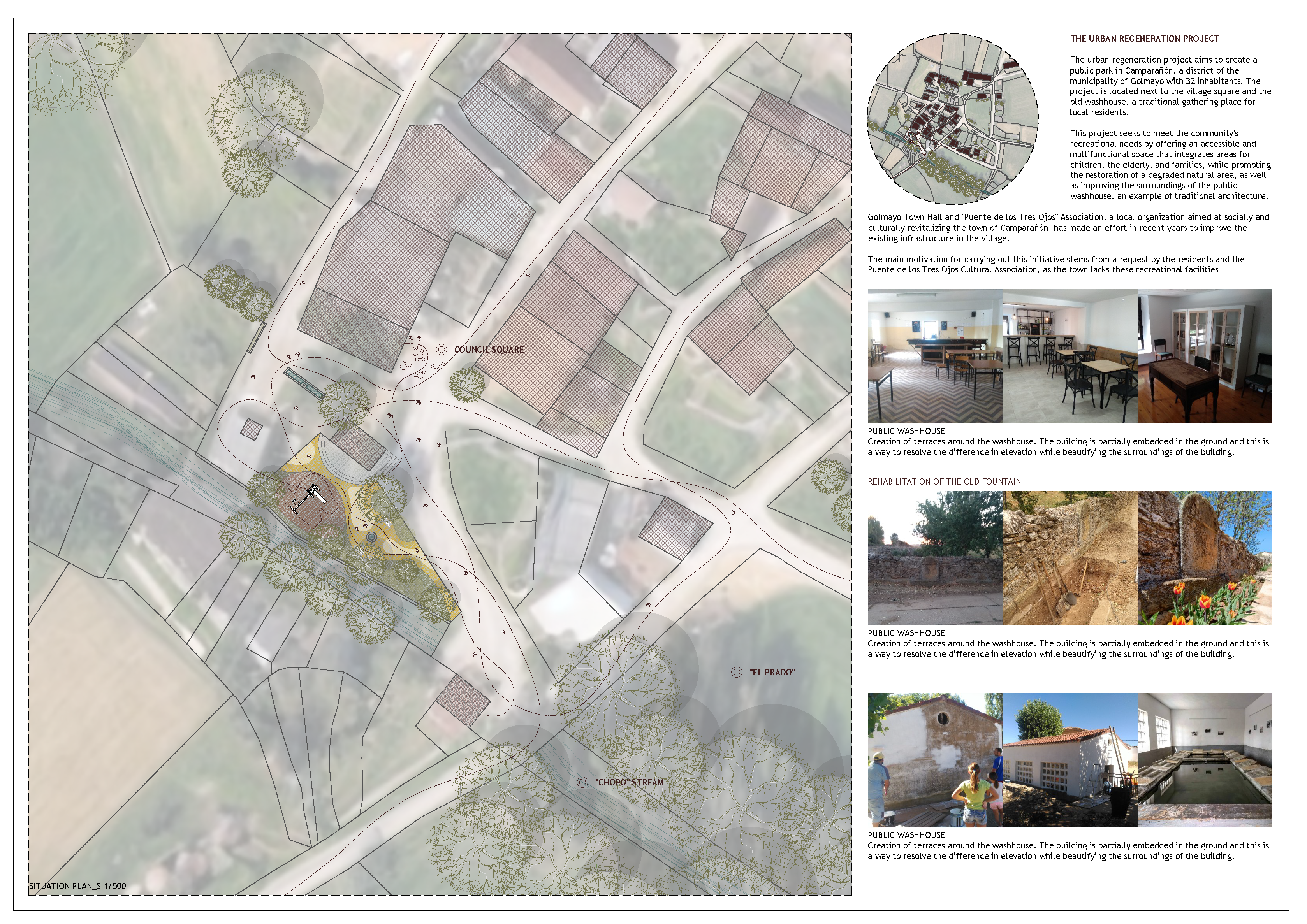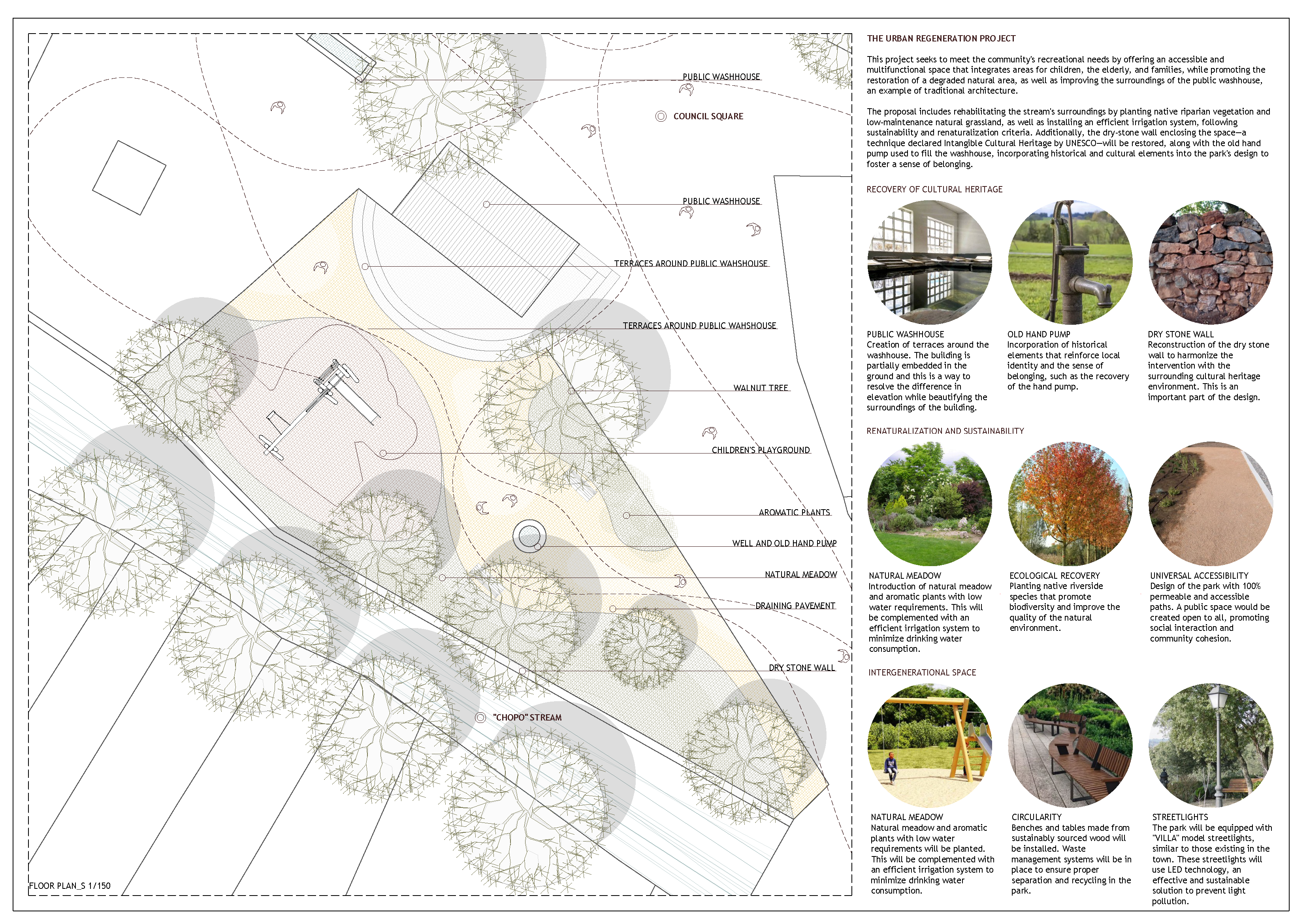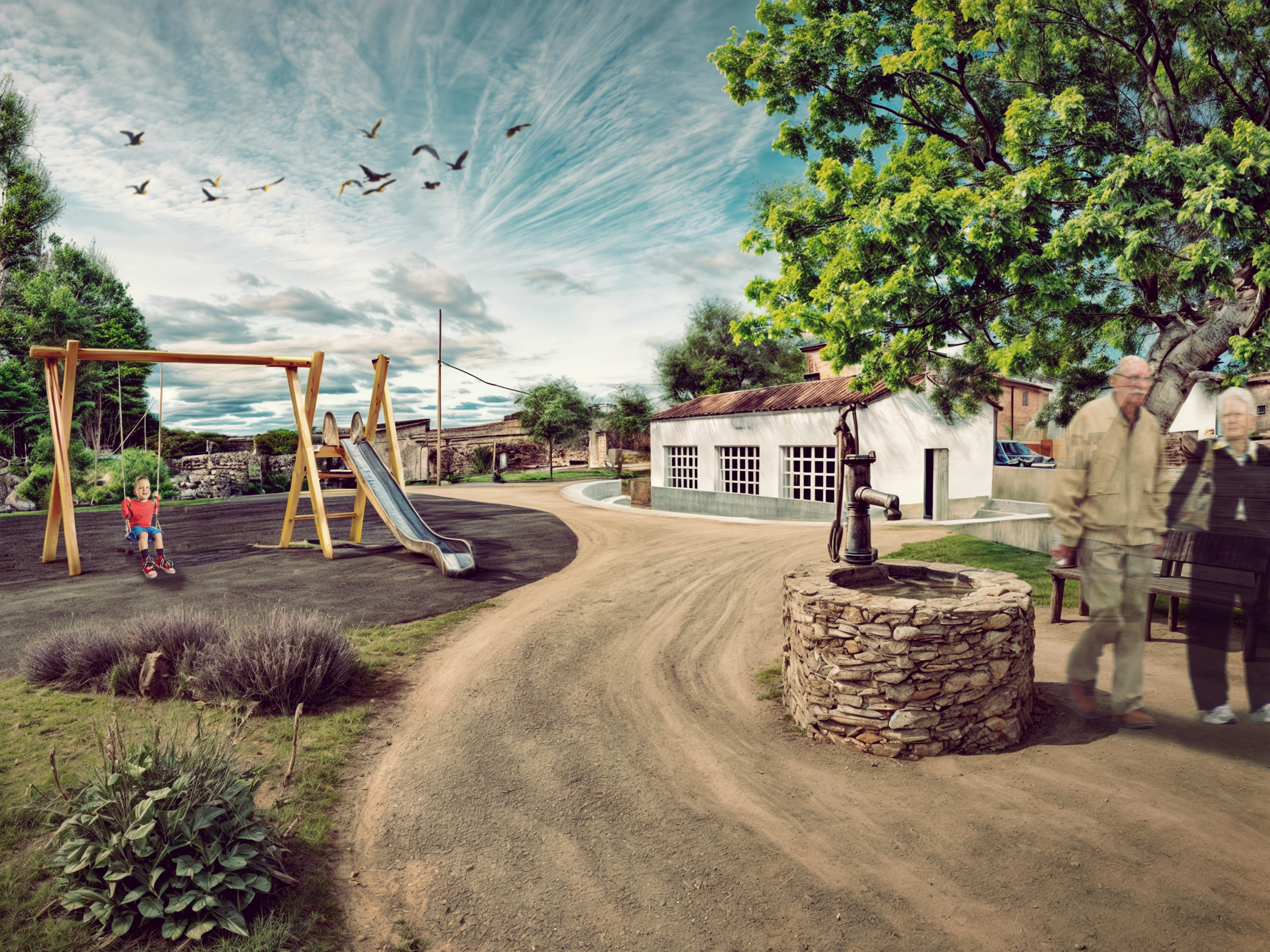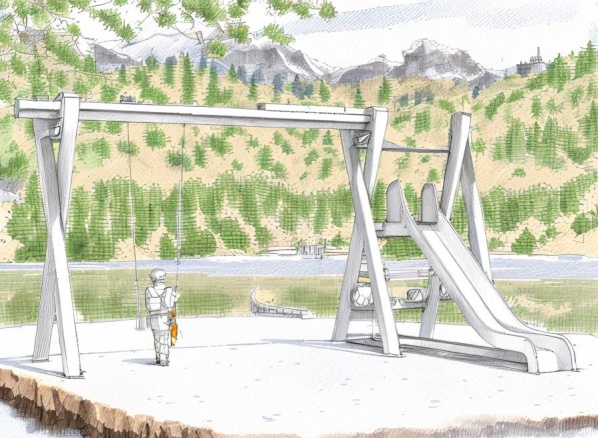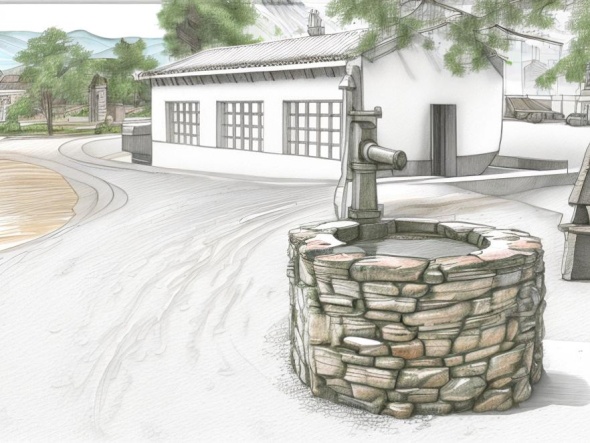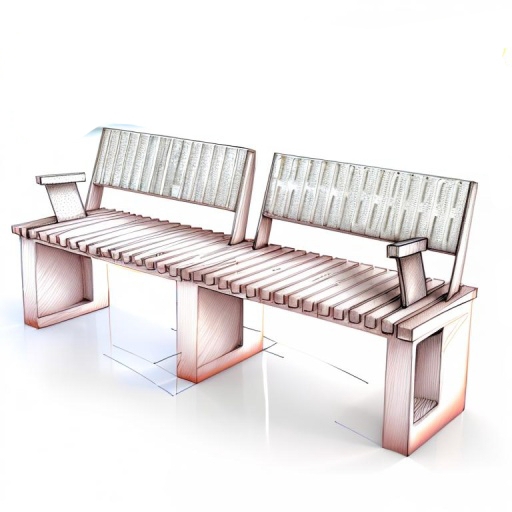Living Roots
Living Roots: Nature and Tradition for the Future
The urban regeneration project aims to create a
public park in Camparañón, a district of the
municipality of Golmayo with 32 inhabitants. The
project is located next to the village square.
This project seeks to meet the community's
recreational needs by offering an accessible and
multifunctional space that integrates areas for
children, the elderly, and families, while promoting
the restoration of a degraded natural area, as well
as improving the surroundings of the washhouse.
public park in Camparañón, a district of the
municipality of Golmayo with 32 inhabitants. The
project is located next to the village square.
This project seeks to meet the community's
recreational needs by offering an accessible and
multifunctional space that integrates areas for
children, the elderly, and families, while promoting
the restoration of a degraded natural area, as well
as improving the surroundings of the washhouse.
Spain
{Empty}
Early initiative
Yes
Yes
Yes
No
No
42095: Golmayo (ES)
This project seeks to meet the community's recreational needs by offering an accessible and
multifunctional space that integrates areas for children, the elderly, and families, while promoting the
restoration of a degraded natural area, as well as improving the surroundings of the public washhouse,
an example of traditional architecture.
The proposal includes rehabilitating the stream's surroundings by planting native riparian vegetation and
low-maintenance natural grassland, as well as installing an efficient irrigation system, following
sustainability and renaturalization criteria. Additionally, the dry-stone wall enclosing the space—a
technique declared Intangible Cultural Heritage by UNESCO—will be restored, along with the old hand
pump used to fill the washhouse, incorporating historical and cultural elements into the park's design to
foster a sense of belonging.
Epecific objectives and expected outcomes:
Impact on the local community
1. Improved quality of life through accessible space for recreational, social and educational activities.
2. Strengthening the sense of local identity through the valorisation of cultural and natural heritage.
3. Creation of an intergenerational space that fosters social cohesion, interaction and well-being of residents.
Environmental impact
1. Recovery of a degraded natural space, promoting biodiversity.
2. Reduction of the ecological footprint through the use of sustainable materials and efficient irrigation techniques.
3. Increased resilience to climate change by restoring riverside ecosystems.
Cultural impact
1. Rescue and valorisation of traditional techniques such as dry stone and industrial heritage.
2. Environmental and cultural education through intergenerational activities.
multifunctional space that integrates areas for children, the elderly, and families, while promoting the
restoration of a degraded natural area, as well as improving the surroundings of the public washhouse,
an example of traditional architecture.
The proposal includes rehabilitating the stream's surroundings by planting native riparian vegetation and
low-maintenance natural grassland, as well as installing an efficient irrigation system, following
sustainability and renaturalization criteria. Additionally, the dry-stone wall enclosing the space—a
technique declared Intangible Cultural Heritage by UNESCO—will be restored, along with the old hand
pump used to fill the washhouse, incorporating historical and cultural elements into the park's design to
foster a sense of belonging.
Epecific objectives and expected outcomes:
Impact on the local community
1. Improved quality of life through accessible space for recreational, social and educational activities.
2. Strengthening the sense of local identity through the valorisation of cultural and natural heritage.
3. Creation of an intergenerational space that fosters social cohesion, interaction and well-being of residents.
Environmental impact
1. Recovery of a degraded natural space, promoting biodiversity.
2. Reduction of the ecological footprint through the use of sustainable materials and efficient irrigation techniques.
3. Increased resilience to climate change by restoring riverside ecosystems.
Cultural impact
1. Rescue and valorisation of traditional techniques such as dry stone and industrial heritage.
2. Environmental and cultural education through intergenerational activities.
Renaturalization
Sustainability
Accessibility
Intergenerational space
Cultural heritage
The project aims to regenerate the local ecosystem and close the resource cycle to achieve environmental neutrality.
Ecological Restoration:
Planting native riparian species that enhance biodiversity and improve the quality of the natural environment. Introducing a natural meadow with low water requirements, complemented by an efficient irrigation system that utilizes rainwater and minimizes potable water consumption. Restoring the Arroyo del Chopo to improve its ecological quality and strengthen associated ecosystems, fostering biodiversity and stabilizing its banks.
Use of Local and Traditional Materials:
Rebuilding the dry-stone perimeter using traditional techniques, reducing environmental impact by using local materials and non-polluting methods. Installing benches and tables made from sustainably sourced wood. Implementing waste management systems to ensure proper sorting and recycling within the park.
Long-Term Vision:
Encouraging a paradigm shift that promotes a lasting balance between human development and environmental conservation through community education in sustainable practices, such as workshops and activities, fostering a lifestyle more in harmony with nature.
The restoration of a degraded natural area not only promotes biodiversity but also helps reduce the ecological footprint through the use of sustainable materials and efficient irrigation techniques while enhancing resilience to climate change by restoring riparian ecosystems.
Ecological Restoration:
Planting native riparian species that enhance biodiversity and improve the quality of the natural environment. Introducing a natural meadow with low water requirements, complemented by an efficient irrigation system that utilizes rainwater and minimizes potable water consumption. Restoring the Arroyo del Chopo to improve its ecological quality and strengthen associated ecosystems, fostering biodiversity and stabilizing its banks.
Use of Local and Traditional Materials:
Rebuilding the dry-stone perimeter using traditional techniques, reducing environmental impact by using local materials and non-polluting methods. Installing benches and tables made from sustainably sourced wood. Implementing waste management systems to ensure proper sorting and recycling within the park.
Long-Term Vision:
Encouraging a paradigm shift that promotes a lasting balance between human development and environmental conservation through community education in sustainable practices, such as workshops and activities, fostering a lifestyle more in harmony with nature.
The restoration of a degraded natural area not only promotes biodiversity but also helps reduce the ecological footprint through the use of sustainable materials and efficient irrigation techniques while enhancing resilience to climate change by restoring riparian ecosystems.
The project not only meets functional needs but also creates an enriching experience that connects people with their natural and cultural surroundings.
Integrated and Culturally Significant Design:
Incorporation of the traditional washhouse and dry-stone enclosure as key design elements, harmonizing with the existing cultural heritage at the heart of the community. Well-designed green spaces featuring shaded areas, attractive vegetation, and a peaceful setting by the stream. Integration of sensory-stimulating elements such as the stream, the fountain, and newly introduced plant species.
Emotional Connection and Enriching Experience:
Restoration of historical elements that reinforce local identity and a sense of belonging, such as the washhouse surroundings and the recovery of the hand pump. Integration of neglected and unused spaces into residents' daily lives. A design that encourages relaxation, play, and social interaction in a natural environment.
The project aims to enhance quality of life by providing an accessible space for recreational, social, and educational activities while strengthening local identity through the appreciation of cultural and natural heritage. Additionally, it creates an intergenerational environment that fosters social cohesion, interaction, and the well-being of residents.
Integrated and Culturally Significant Design:
Incorporation of the traditional washhouse and dry-stone enclosure as key design elements, harmonizing with the existing cultural heritage at the heart of the community. Well-designed green spaces featuring shaded areas, attractive vegetation, and a peaceful setting by the stream. Integration of sensory-stimulating elements such as the stream, the fountain, and newly introduced plant species.
Emotional Connection and Enriching Experience:
Restoration of historical elements that reinforce local identity and a sense of belonging, such as the washhouse surroundings and the recovery of the hand pump. Integration of neglected and unused spaces into residents' daily lives. A design that encourages relaxation, play, and social interaction in a natural environment.
The project aims to enhance quality of life by providing an accessible space for recreational, social, and educational activities while strengthening local identity through the appreciation of cultural and natural heritage. Additionally, it creates an intergenerational environment that fosters social cohesion, interaction, and the well-being of residents.
Universal Accessibility:
Park design with accessible pathways for people with reduced mobility and inclusive areas for all ages and abilities. Recreational zones designed for both children and the elderly, ensuring an intergenerational space.
Citizen and Equitable Participation:
Addressing existing demands by identifying needs and preferences, involving residents and the local association. Enhancing educational activities led by the local association to raise awareness of sustainability and cultural heritage, engaging youth, the elderly, and local groups.
Social Interaction and Reduction of Inequalities:
Creating a public space open to everyone, fostering social interaction and community cohesion.
Promoting intergenerational cohesion and dialogue between different social groups.
Incorporating recreational infrastructure currently lacking in the village compared to other population centers in the municipality.
Park design with accessible pathways for people with reduced mobility and inclusive areas for all ages and abilities. Recreational zones designed for both children and the elderly, ensuring an intergenerational space.
Citizen and Equitable Participation:
Addressing existing demands by identifying needs and preferences, involving residents and the local association. Enhancing educational activities led by the local association to raise awareness of sustainability and cultural heritage, engaging youth, the elderly, and local groups.
Social Interaction and Reduction of Inequalities:
Creating a public space open to everyone, fostering social interaction and community cohesion.
Promoting intergenerational cohesion and dialogue between different social groups.
Incorporating recreational infrastructure currently lacking in the village compared to other population centers in the municipality.
The project fosters active community participation through intergenerational activities, such as community tree planting and vegetation days, promoting connections between neighbors of different ages and strengthening the sense of belonging. Additionally, workshops are held in which the community participates in defining priorities and restoring the space, ensuring that the project responds to their needs and expectations.
To ensure the long-term sustainability of the project, local empowerment is encouraged by allowing residents to take an active role in managing the environment, strengthening their involvement and commitment to the area's development.
Furthermore, the project introduces a model of community governance based on self-management and active participation, promoting a collaborative approach. In this way, a truly inclusive and sustainable space is created, where the community plays a key role in its conservation and evolution over time.
To ensure the long-term sustainability of the project, local empowerment is encouraged by allowing residents to take an active role in managing the environment, strengthening their involvement and commitment to the area's development.
Furthermore, the project introduces a model of community governance based on self-management and active participation, promoting a collaborative approach. In this way, a truly inclusive and sustainable space is created, where the community plays a key role in its conservation and evolution over time.
The project fosters connections between local stakeholders and broader networks and programs, facilitating collaboration and knowledge exchange. Through horizontal interaction, it engages with neighboring municipalities to share experiences and best practices related to similar regeneration projects. This cooperative approach strengthens regional ties and enhances collective expertise in environmental and cultural restoration efforts.
At the same time, vertical interaction ensures coordination with regional and national institutions, aligning the project with existing regulations and sustainability strategies. By integrating local initiatives into broader frameworks, the project not only secures compliance but also contributes to long-term environmental and heritage conservation goals at multiple governance levels.
Beyond its local impact, the project aspires to have a global reach by documenting its process as a replicable model for other European municipalities. Its methodologies and techniques are designed to be easily adaptable, making it a valuable reference for small towns with rural or degraded environments seeking sustainable and community-driven regeneration solutions.
At the same time, vertical interaction ensures coordination with regional and national institutions, aligning the project with existing regulations and sustainability strategies. By integrating local initiatives into broader frameworks, the project not only secures compliance but also contributes to long-term environmental and heritage conservation goals at multiple governance levels.
Beyond its local impact, the project aspires to have a global reach by documenting its process as a replicable model for other European municipalities. Its methodologies and techniques are designed to be easily adaptable, making it a valuable reference for small towns with rural or degraded environments seeking sustainable and community-driven regeneration solutions.
The project is characterized by multidisciplinary collaboration, integrating various areas of knowledge to address the regeneration of the space in a comprehensive way. Architecture and landscaping are combined for the design of recreational and green areas, history and anthropology for the restoration of the washhouse using traditional techniques, and ecology and sustainability for the renaturalization of the stream environment, creating a space that respects both cultural heritage and the natural environment.
Additionally, the project promotes the integration of knowledge, combining traditional techniques at risk of disappearing, such as dry-stone construction, with modern renaturalization practices. These include the use of efficient irrigation systems and the accessible and inclusive design of spaces, allowing for an intervention that is respectful of the environment, low-maintenance, and adapted to the needs of the community.
Finally, the project fosters educational innovation through workshops organized by the local association, aimed at educating the community on sustainability and cultural heritage. These workshops not only promote learning and environmental awareness but also strengthen the connection between residents and their surroundings, ensuring the transmission of knowledge and values to future generations.
Additionally, the project promotes the integration of knowledge, combining traditional techniques at risk of disappearing, such as dry-stone construction, with modern renaturalization practices. These include the use of efficient irrigation systems and the accessible and inclusive design of spaces, allowing for an intervention that is respectful of the environment, low-maintenance, and adapted to the needs of the community.
Finally, the project fosters educational innovation through workshops organized by the local association, aimed at educating the community on sustainability and cultural heritage. These workshops not only promote learning and environmental awareness but also strengthen the connection between residents and their surroundings, ensuring the transmission of knowledge and values to future generations.
The innovative character of this initiative lies in its comprehensive, community-centered approach, which combines traditional practices with modern sustainability techniques, providing a unique and complete solution to multiple challenges.
Unlike other contemporary projects that focus solely on modern techniques, this initiative merges traditional knowledge—such as dry-stone construction and the restoration of historical elements—with current sustainable practices like efficient irrigation systems and low-maintenance renaturalization methods. This approach not only preserves cultural heritage but also ensures long-term environmental sustainability, making it a unique and innovative model for rural regeneration.
While in many conventional projects the planning and decision-making process is mainly hierarchical, this initiative places a strong emphasis on active community participation and co-design. It empowers local residents by involving them in the planning process through workshops and community activities such as tree planting.
This initiative is designed to be replicable in other small municipalities, especially those in rural or degraded environments. The combination of ecological restoration, cultural preservation, and sustainable design offers a model that can be adapted to various local contexts. Documenting the process and outcomes as a replicable model for other municipalities makes it an innovative reference for future projects in Europe.
Unlike other contemporary projects that focus solely on modern techniques, this initiative merges traditional knowledge—such as dry-stone construction and the restoration of historical elements—with current sustainable practices like efficient irrigation systems and low-maintenance renaturalization methods. This approach not only preserves cultural heritage but also ensures long-term environmental sustainability, making it a unique and innovative model for rural regeneration.
While in many conventional projects the planning and decision-making process is mainly hierarchical, this initiative places a strong emphasis on active community participation and co-design. It empowers local residents by involving them in the planning process through workshops and community activities such as tree planting.
This initiative is designed to be replicable in other small municipalities, especially those in rural or degraded environments. The combination of ecological restoration, cultural preservation, and sustainable design offers a model that can be adapted to various local contexts. Documenting the process and outcomes as a replicable model for other municipalities makes it an innovative reference for future projects in Europe.
The methodology used in this initiative is based on a participatory, integrated, and sustainable approach that combines traditional knowledge with modern techniques, fosters community participation, and prioritizes environmental and social well-being. The approach is designed to create a regeneration model that can be replicated in other similar contexts.
At the core of the project is the active participation of the community. This participatory process includes workshops, community meetings, and activities such as tree planting and environmental education events. Through these interactions, the initiative ensures that the needs, desires, and values of the community are reflected in the design, while also empowering residents to take ownership and responsibility for the long-term success and sustainability of the project.
The project integrates knowledge from various disciplines, such as architecture, ecology, anthropology, and traditional construction techniques. This multidisciplinary collaboration ensures that the design and restoration of the spaces are based on both local cultural heritage and modern sustainable practices. For example, the restoration of historical elements, such as traditional washhouses and dry-stone walls, is combined with modern ecological restoration practices, such as the renaturalization of the stream, the creation of green spaces, and efficient water management systems. This approach ensures that the project is both culturally relevant and environmentally sustainable.
Sustainability is a central principle of the methodology. The project focuses on low-impact design and ecological restoration, incorporating features such as efficient water use, native plant species, and low-maintenance ecosystems. The design prioritizes biodiversity, uses sustainable materials, and implements green infrastructure that supports both environmental health and community well-being.
At the core of the project is the active participation of the community. This participatory process includes workshops, community meetings, and activities such as tree planting and environmental education events. Through these interactions, the initiative ensures that the needs, desires, and values of the community are reflected in the design, while also empowering residents to take ownership and responsibility for the long-term success and sustainability of the project.
The project integrates knowledge from various disciplines, such as architecture, ecology, anthropology, and traditional construction techniques. This multidisciplinary collaboration ensures that the design and restoration of the spaces are based on both local cultural heritage and modern sustainable practices. For example, the restoration of historical elements, such as traditional washhouses and dry-stone walls, is combined with modern ecological restoration practices, such as the renaturalization of the stream, the creation of green spaces, and efficient water management systems. This approach ensures that the project is both culturally relevant and environmentally sustainable.
Sustainability is a central principle of the methodology. The project focuses on low-impact design and ecological restoration, incorporating features such as efficient water use, native plant species, and low-maintenance ecosystems. The design prioritizes biodiversity, uses sustainable materials, and implements green infrastructure that supports both environmental health and community well-being.
The project will be documented as a replicable model for other European municipalities, especially for small ones with rural or degraded environments. The techniques and methodologies used are easily adaptable to different local contexts. It is a transformative proposal that includes participatory processes and a replicable impact, demonstrating how small communities can lead the transition toward a greener, fairer, and more beautiful future. By integrating tradition, sustainability, and innovation alongside local stakeholders, this project becomes an example to follow for other municipalities.
This initiative addresses several global challenges by offering local solutions that contribute to broader environmental, social, and cultural goals. Here are some of the main challenges it tackles:
The project promotes ecological restoration and sustainable practices through the regeneration of natural spaces, such as the renaturalization of the stream and the use of low-maintenance techniques. By prioritizing biodiversity, efficient water management, and the use of sustainable materials, it helps mitigate the impacts of climate change at the local level, contributing to global environmental preservation.
The creation of an intergenerational and inclusive public space fosters social cohesion by providing areas where people of all ages and backgrounds can interact with each other. By addressing the needs of marginalized or underserved communities, the project promotes equality, community engagement, and collective well-being, contributing to the global fight against inequality.
Through the restoration of significant historical elements, such as the traditional washhouse and dry-stone construction, the project safeguards local heritage. It helps preserve and transmit cultural practices at risk of disappearing, tackling the global challenge of cultural loss and promoting the value of local knowledge.
The initiative provides a model for how small municipalities, especially those in rural or degraded areas, can lead sustainable urban development. By combining innovation with traditional techniques, it fosters low-impact solutions that can be replicated elsewhere, offering a reference for sustainable development in the face of rapid urbanization and unsustainable growth.
The project promotes ecological restoration and sustainable practices through the regeneration of natural spaces, such as the renaturalization of the stream and the use of low-maintenance techniques. By prioritizing biodiversity, efficient water management, and the use of sustainable materials, it helps mitigate the impacts of climate change at the local level, contributing to global environmental preservation.
The creation of an intergenerational and inclusive public space fosters social cohesion by providing areas where people of all ages and backgrounds can interact with each other. By addressing the needs of marginalized or underserved communities, the project promotes equality, community engagement, and collective well-being, contributing to the global fight against inequality.
Through the restoration of significant historical elements, such as the traditional washhouse and dry-stone construction, the project safeguards local heritage. It helps preserve and transmit cultural practices at risk of disappearing, tackling the global challenge of cultural loss and promoting the value of local knowledge.
The initiative provides a model for how small municipalities, especially those in rural or degraded areas, can lead sustainable urban development. By combining innovation with traditional techniques, it fosters low-impact solutions that can be replicated elsewhere, offering a reference for sustainable development in the face of rapid urbanization and unsustainable growth.
This project is an opportunity to transform a degraded space into a functional, inclusive, and sustainable environment that benefits both current and future generations, in continuity with other initiatives already implemented in the area.
With a design focused on the values of the European New Bauhaus, the regeneration of the public park and natural surroundings will become an example of how small municipalities can lead comprehensive sustainability and cultural preservation initiatives.
A transformative proposal, participatory processes, and a replicable impact, this project aims to show how small communities can lead the transition toward a greener, fairer, and more beautiful future. By connecting tradition, sustainability, and innovation with local stakeholders, this project becomes a replicable model for other municipalities.
With a design focused on the values of the European New Bauhaus, the regeneration of the public park and natural surroundings will become an example of how small municipalities can lead comprehensive sustainability and cultural preservation initiatives.
A transformative proposal, participatory processes, and a replicable impact, this project aims to show how small communities can lead the transition toward a greener, fairer, and more beautiful future. By connecting tradition, sustainability, and innovation with local stakeholders, this project becomes a replicable model for other municipalities.

